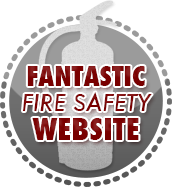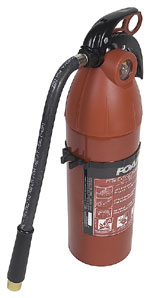Fire Extinguisher : 101
Fire Extinguisher Types (What Kind do I use?)
| Home |
| About Fire Extinguishers |
| Using a Fire Extinguisher |
| Fire Prevention |
| Fire Hazards |
| First Aid for Fire |
| Financial Protection |
| Biggest Fires in History |
| Firefighters |
This site was voted:

by onlinefiresciencedegree.org
(scroll to 74 on the list)
This site is intended to provide individuals with general information pertaining to fire extinguisher types and fire prevention. |
With so many fire extinguishers to choose from, selecting the proper one for your home can be a daunting task. Everyone should have at least one fire extinguisher at home, but it's just as important to ensure you have the proper type of fire extinguisher. Fire protection experts recommend one for the kitchen, the garage and workshop.
Fire extinguishers are divided into four categories, based on different types of fires. Each fire extinguisher also has a numerical rating that serves as a guide for the amount of fire the extinguisher can handle. The higher the number, the more fire-fighting power. The following is a quick guide to help choose the right type of extinguisher. Also see how to buy a fire extinguisher.
 |
|
Some fires may involve a combination of these classifications. Your fire extinguishers should have ABC ratings on them.
Here are the most common types of fire extinguishers:
 |
|
Dry chemical extinguishers have an advantage over CO2 extinguishers since they leave a non-flammable substance on the extinguished material, reducing the likelihood of re-ignition.
- Carbon Dioxide (CO2) extinguishers are used for class B and C fires. CO2 extinguishers contain carbon dioxide, a non-flammable gas, and are highly pressurized. The pressure is so great that it is not uncommon for bits of dry ice to shoot out the nozzle. They don't work very well on class A fires because they may not be able to displace enough oxygen to put the fire out, causing it to re-ignite.
CO2 extinguishers have an advantage over dry chemical extinguishers since they don't leave a harmful residue - a good choice for an electrical fire on a computer or other favorite electronic device such as a stereo or TV.
| It
is vital to know what type of extinguisher you are using. Using
the wrong type of extinguisher for the wrong type of fire can be
life-threatening. |
These are only the common types of fire extinguishers. There are many others to choose from. Base your selection on the classification and the extinguisher's compatibility with the items you wish to protect.
Read about the Benefits and Applications of an Automatic Fire Extinguishers.
Articles:
The
Comeback of Fire Extinguishing Balls and their Benefits new
The
Basics of Firefighter Training
Examining
the Basics of Fire Sprinkler Systems
Kitchen
Fire Safety 101
Wildfire
Protection for You and Your Home
Garden
Torch Candles Defined
Arson Statistics: Who is setting the
fires and how often does arson occur?
Top
Key Tips to Filing a Fire Insurance Claim
Holiday Fire Safety
Fire Safe Cigarettes
Save Lives
Understanding Electrical
Fire Safety
Wildfire Prevention
Tips: Protect your Home and Property
Wood Fire Safety
101
Other Interests:
Sparky the Fire Dog?
- The official mascot of the “National Fire Protection Association”.
Car Fire Extinguisher?
- Yes, they have those too. Explains what to look for in a car fire extinguisher.
A Tribute to Firefighters
- Learn about the men and women, who risk their lives daily to keep our
homes and communities safe from the damaging and potentially fatal effects
of fire.